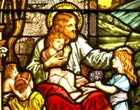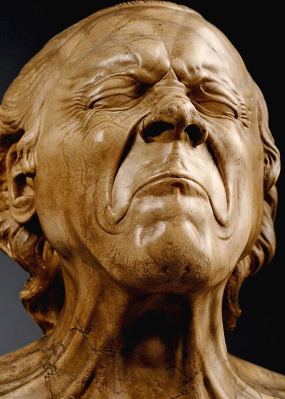Jesus restores a young girl to life
Questions for Bible study groups
- Who was the girl in this story, and what happened to her?
- What did her father do?
- What did Jesus do? What sensible suggestion did he make?
- How does this miracle story link to the story of Dorcas?
This miracle shows Jesus’ authority over death. It also illustrates later Christian teaching about death: it is a sleep from which we will one day awake, when we hear the Savior’s voice.
The daughter of Jairus is dying
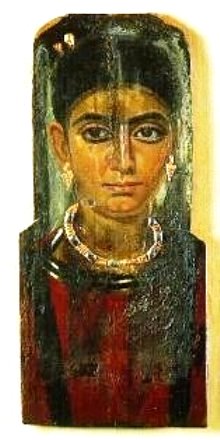 Jairus was an important man in the community. He was the ‘ruler’ of the synagogue, and thus a man of learning (much valued by the Jewish people) and some organizational skill. Synagogues were a recent innovation in 1st century Palestine, and the men in charge of them were presumably the best and brightest.
Jairus was an important man in the community. He was the ‘ruler’ of the synagogue, and thus a man of learning (much valued by the Jewish people) and some organizational skill. Synagogues were a recent innovation in 1st century Palestine, and the men in charge of them were presumably the best and brightest.
But he had been hit by the worst tragedy a person can face: the death of a child, in this case a beloved young daughter on the threshold of womanhood. She was twelve years old, and had been struck down by some unnamed illness or disease.
Jesus, reputed as a great healer, was in the neighbourhood, and Jairus sought him out in a last-ditch attempt to save his daughter. In his anguish he cast aside his dignity and fell at Jesus’ feet. He begged Jesus to come and heal the girl. She was at the point of death, but even now it might not be too late.
Jesus responded immediately. He would come. Jairus was relieved, and they started the journey to his house, accompanied by a large crowd of curious people. Walking close to Jesus were Peter, James and John, the three core disciples who would be with him later, at the Transfiguration and in the garden of Gethsemane.
Read the blue text at bottom of this page
Jairus’ daughter dies
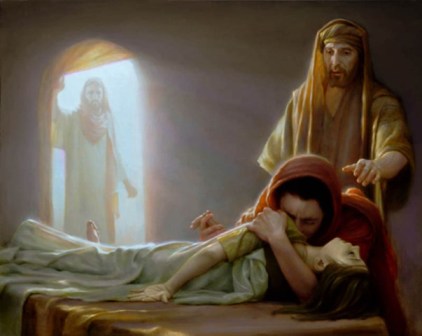 Before they reached the house the girl died. Her anguished father was overcome by grief, but Jesus reassured him. She was not dead, Jesus said, but merely sleeping.
Before they reached the house the girl died. Her anguished father was overcome by grief, but Jesus reassured him. She was not dead, Jesus said, but merely sleeping.
People in the crowd around him were no doubt sceptical, but they kept going until they reached the house.
There they found the official mourning already underway. Among the throng were flute-players and professional mourners hired for the funeral. So we can assume that the journey to the house has taken some time (Jesus and the people with him were on foot). In the meantime the girl had died, been certified as such, and her body prepared for burial.
Jesus told the professional mourners to leave. There was no need to pay for services that were not required. The girl was not dead but sleeping – in a coma? All three gospels make a point of saying that the people at the house laughed out loud at his naiveté. They were quite capable, they thought, of telling when someone was dead.
This was fair enough. Family members, with the help of people with specialised skills, prepared a dead body for burial; they would certainly have seen and prepared other dead bodies before this day. Moreover, funeral rites took place quite quickly after death in the hot climate of the ancient East.
Read the green gospel texts at bottom of this page
Jesus lifts the girl up from death
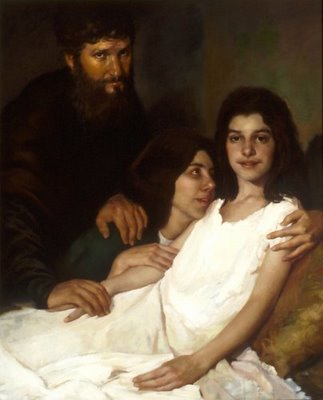
But Jesus persisted. He called for silence, then he ejected the crowd of mourners, allowing only her parents and his three disciples to remain. The room became calm, silent. Into the stillness came Jesus’ voice. “Ta’litha cu’mi” he said – Get up, little girl.
As Luke, a practiser of medicine, notes, her ‘spirit’ returned. Life came back into her inert body. And not just life but strength. She got up from the bed and walked.
Read the red text at bottom of page
‘Give her something to eat’
 Then Jesus showed he was not just a miracle-worker, but a practical and kindly man as well: he told her parents to give her something to eat. She had not eaten for some time and must be hungry. People often forget that Jesus was a peasant from an ordinary rural community. He healed people, but he also cared about their well-being.
Then Jesus showed he was not just a miracle-worker, but a practical and kindly man as well: he told her parents to give her something to eat. She had not eaten for some time and must be hungry. People often forget that Jesus was a peasant from an ordinary rural community. He healed people, but he also cared about their well-being.
The story has what seems like a strange addendum: Jesus told the people who were present not to talk about it with others – a faint hope in the circumstances. We wonder why, until we realise that at this stage Jesus was attracting more attention than he wanted. Attention meant crowds, and crowds could mean danger if the authorities saw Jesus as a potential rebel against authority, Jewish or Roman.
Read the black gospel text at bottom of page
Comment
There are echoes of this story in the raising of Dorcas in Acts 9:36-43. Peter, who has been present at the raising of Jairus’ daughter, had enough faith in the power of Jesus to raise another woman out of death.
What happened next? See Miracle of the Loaves and Fishes
What the Gospels say
1. The young daughter of Jairus is dying. Read the blue text
2. Jairus’ daughter dies. Read the green text
3. Jesus lifts the girl up from death. Read the red text
4. ‘Give her something to eat…’ Read the black text
Matthew 9:18-19, 23-26
18 While he was thus speaking to them, behold, a ruler came in and knelt before him, saying, “My daughter has just died; but come and lay your hand on her, and she will live.” 19 And Jesus rose and followed him, with his disciples….
23 And when Jesus came to the ruler’s house, and saw the flute players, and the crowd making a tumult, 24 he said, “Depart; for the girl is not dead but sleeping.” And they laughed at him. 25 But when the crowd had been put outside, he went in and took her by the hand, and the girl arose.
26 And the report of this went through all that district.
Mark 5:22-24, 35-43
22 Then came one of the rulers of the synagogue, Jairus by name; and seeing him, he fell at his feet, 23 and besought him, saying, “My little daughter is at the point of death. Come and lay your hands on her, so that she may be made well, and live.” 24 And he went with him. And a great crowd followed him and thronged about him…
35 While he was still speaking, there came from the ruler’s house some who said, “Your daughter is dead. Why trouble the Teacher any further?” 36 But ignoring what they said, Jesus said to the ruler of the synagogue, “Do not fear, only believe.” 37 And he allowed no one to follow him except Peter and James and John the brother of James.
38 When they came to the house of the ruler of the synagogue, he saw a tumult, and people weeping and wailing loudly. 39 And when he had entered, he said to them, “Why do you make a tumult and weep? The child is not dead but sleeping.” 40 And they laughed at him. But he put them all outside, and took the child’s father and mother and those who were with him, and went in where the child was. 41 Taking her by the hand he said to her, “Tal’itha cu’mi”; which means, “Little girl, I say to you, arise.” 42 And immediately the girl got up and walked (she was twelve years of age), and they were immediately overcome with amazement.
43 And he strictly charged them that no one should know this, and told them to give her something to eat.
Luke 8:40-42, 49-56
40 Now when Jesus returned, the crowd welcomed him, for they were all waiting for him. 41 And there came a man named Jairus, who was a ruler of the synagogue; and falling at Jesus’ feet he besought him to come to his house, 42 for he had an only daughter, about twelve years of age, and she was dying…
49 While he was still speaking, a man from the ruler’s house came and said, “Your daughter is dead; do not trouble the Teacher any more.” 50 But Jesus on hearing this answered him, “Do not fear; only believe, and she shall be well.” 51 And when he came to the house, he permitted no one to enter with him, except Peter and John and James, and the father and mother of the child.
52 And all were weeping and bewailing her; but he said, “Do not weep; for she is not dead but sleeping.” 53 And they laughed at him, knowing that she was dead. 54 But taking her by the hand he called, saying, “Child, arise.” 55 And her spirit returned, and she got up at once; and he directed that something should be given her to eat. 56 And her parents were amazed;
but he charged them to tell no one what had happened.

The Raising of Jairus’ Daughter, Vasiliy Polenov, 1871

